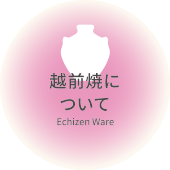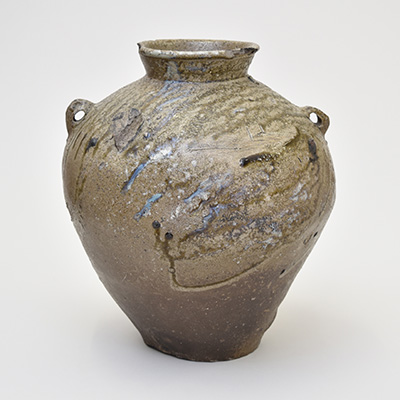 page top |
 wood-fired kind in Fukui Prefecture can be dated back to the 6th century CE, when the production of Sue ware began. Unlike traditional Haji ware (a type of earthenware) and Haniwa (terracotta figures), Sue ware was fired to a high temperature in a reduced atmosphere in an anagama. Sue ware was actively produced in Fukui Prefecture. The Nyu old kiln sites were in production from the 8th century to the 10th century, centring on the present-day Echizen town. The remains of sixty-one kilns have been discovered at these sites.   Echizen kiln, which is known as one of the Six Ancient Kilns of Japan, began production in the latter half of the 12th century, mainly in Echizen town, where the remains of the Nyu old kiln sites existed. The Echizen kiln was established by introducing the technology of Tokoname kiln sites exsited. The Echizen kiln was established by introducing the technology of Tokoname kiln in Aichi Prefecture, and mainly produced pots, jars, and mortar bowls. The remains of more than 200 kilns have been found, most of which are anagama kilns. The length of the kilns ranged from approximately 14m- as in the Kamichosa No.5 kiln (see far right, in photograph at left) in the latter half of the 12th century, but increased in size over time, reaching 24m in the latter half of the 16th century, as in the Dakenodan No.1 kiln. In the 16th century the Echizen kiln reached its peak, and its products for use in daily life were widely distributed from Hokkaido to Shimane Prefecture on the Sea of Japan side, and to Fukusihma Prefecture on the Pacific side. The characterristics of Old Echizen ware are the reddish-brown body and the dark green natural glaze over it (see photographs above), The jar in the photograph at right probably fell over during firing, and consequently rivulets of natural ash glaze can be seen flowing in more than one direction on its surface. In the Edo period (1600-1868), Echizen began to produce many different types of products including sake bottles, braziers, and ikebana wares. In the 1840s climbing chamber kilns, which are more efficient then anagama kilns were introduced. Mizuno Kuemon, a leading researcher of the Old Echizen and one of the names of Echizen ware, created a repoduction of the Kamakura period anagama kiln, to conduct experimental firings in an effort to reproduction the qualities and effects of Echizen ware. In the fourth firing experiment conducted in 1993 after Mr.Mizuno's death, 21.5 tonnes of wood were used during a 149 hour firing, and a temperature of approximately 1300℃ was achieved. The results of these experimental firings of the Mizuno kiln provided valuable date and probably contributed to an interest in woodfiring amongst contemporary Echizen potters. In Echizen, where pottery has been produced since ancient times, the smoke of wood-fired kilns is still rising today. |